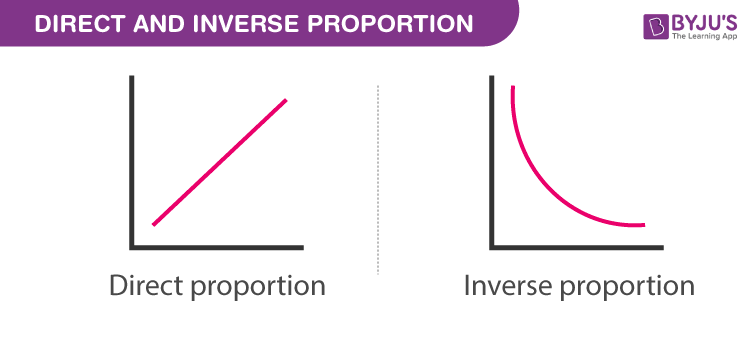When the value of one quantity increases with respect to decrease in other or vice-versa, then they are said to be inversely proportional. It means that the two quantities behave opposite in nature. For example, speed and time are in inverse proportion with each other. As you increase the speed, the time is reduced. The other terms used here for this type of proportion are inverse proportion or varying inversely or inverse variation or reciprocal proportion. Two variables say x and y, which are in inverse proportion are represented as;
x ∝ 1/y or x ∝ y-1
In Mathematics as well as in Physics, we learn about quantities. Some quantities depend upon one another, and such quantities are termed as proportional to one another. In other words, two variables are said to be proportional to each other, if one is changed, then the other is also changed by a fixed amount. This property of variables is known as proportionality. The symbol used to represent the proportionality is “∝.”
There are two types of proportionality of variables. They are:
- Directly Proportional
- Inversely Proportional
Some time we termed these proportionalities as two variables or quantities in direct proportion or inverse proportion.
Inversely Proportional Meaning
Directly proportional variables are those in which if one variable increases, the other also increases. If one variable decreases, the other decreases in the same proportion. Inversely proportional variables are those in which one variable decreases with the increase in another variable and one variable increases with the decrease in another variable. It is opposite to direct proportion. Two quantities are said to be inversely proportional when one quantity is in direct proportion to the reciprocal of others.

Also, read:
| Related Links | |
| Direct and Inverse Proportion | Proportion Formula |
| Ratios and proportion | Basic Proportionality Theorem |
Inversely Proportional Definition
Two variables are called inversely proportional, if and only if the variables are directly proportional to the reciprocal of each other. Or we can say when two variables or quantities are in inverse proportion, then the product of the two variables is equal to a constant value. Ultimately, when the value of one variable increases, then the value of another variable decreases and their product remains constant or unchanged.
Inversely Proportional Formula
If x and y are two quantities which are in inverse variations, then
x ∝ 1/y
x = k(1/y)
Where “k” is a universally positive constant.
It can also be represented as xy = k
If x and y are in inverse variation and x has two values x1 and x2 corresponding to y having two values y1 and y2 respectively, then by the definition of inverse variation, we have
x1 y1 = x2 y2 = (k)
In this case, it becomes
x1 / x2 = y2 / y1 = k
Inversely Proportional Example
Question 1: Find A when B = 500, if A is inversely proportional to B, and also given that A = 200, B = 0.6.
Solution:
Given,
Here A is inversely proportional to B
i.e. A = k (1/B)
Where k is a constant and we get,
k = A x B
Given that,
A = 200 and B = 0.6
So, k = 200 x 0.6 = 120
Therefore, k = 120.
From the above equation, we get
k = 120
Now, substitute the value of k to find A
120 = A x 500
A = (120)/(500) = 0.24
Therefore, A = 0.24
Question 2: Suppose x and y are in an inverse proportion such that, when x = 15, then y = 8. Find the value of y when x = 20.
Solution:
Given,
x ∝ 1/y
x = k/y, where k is a constant
or k = xy
Substituting, x = 15 and y = 8, we get;
k = 15 x 8 = 120
Now, when x = 20, then;
20 y = 120
y = 120/20 = 6
That means, when x is increased to 20 then y decreases to 6.
To learn more interesting Maths-related concepts, download BYJU’S – The Learning App and also watch personalized videos to learn with ease.

